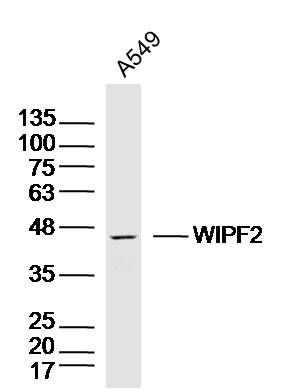产品货号 : mlR9869
英文名称 : WIPF2
中文名称 : WASP结合蛋白抗体
别 名 : WAS/WASL interacting protein family member 2; WASP binding protein; WASP interacting protein related protein; WICH; WIP and CR16 homologous protein; WIP related protein; WIPF 2; WIR; WIPF2_HUMAN.
研究领域 : 心血管 信号转导 细胞骨架
抗体来源 : Rabbit
克隆类型 : Polyclonal
交叉反应 : Human, Mouse, Rat, Dog, Pig,
产品应用 : WB=1:500-2000 ELISA=1:500-1000 IHC-P=1:400-800 IHC-F=1:400-800 IF=1:50-200 (石蜡切片需做抗原修复)
not yet tested in other applications.
optimal dilutions/concentrations should be determined by the end user.
分 子 量 : 46kDa
细胞定位 : 细胞浆
性 状 : Lyophilized or Liquid
浓 度 : 1mg/ml
免 疫 原 : KLH conjugated synthetic peptide derived from human WIPF2:31-130/440
亚 型 : IgG
纯化方法 : affinity purified by Protein A
储 存 液 : 0.01M TBS(pH7.4) with 1% BSA, 0.03% Proclin300 and 50% Glycerol.
保存条件 : Store at -20 °C for one year. Avoid repeated freeze/thaw cycles. The lyophilized antibody is stable at room temperature for at least one month and for greater than a year when kept at -20°C. When reconstituted in sterile pH 7.4 0.01M PBS or diluent of antibody the antibody is stable for at least two weeks at 2-4 °C.
PubMed : PubMed
产品介绍 : WIRE, also known as WIPF2 (WAS/WASL interacting protein family, member 2) or WICH, is a 440 amino acid protein that localizes to both the cytoplasm and the cytoskeleton and contains one WH2 domain. Expressed ubiquitously with highest expression in colon, brain, lung and stomach, WIRE functions as an N-WASP-interacting protein that plays an important role in the organization and mobilization of the Actin cytoskeleton. Additionally, WIRE is involved in the formation of cell surface protrusions and may also provide a link between the cytoskeletal machinery and PDGF-B receptors. Multiple alternatively spliced isoforms of WIRE exist and are encoded by a gene that maps to human chromosome 17.
Function:
Plays an active role in the formation of cell surface protrusions downstream of activated PDGFB receptors. Plays an important role in actin-microspike formation through cooperation with WASL. May cooperate with WASP and WASL to induce mobilization and reorganization of the actin filament system.
Subunit:
Interacts with WASL and WASP, and this interaction results in cytoplasmic relocation of these two proteins along actin filaments. Interacts with NCK2 resulting in the localization to sites of focal adhesions. No interaction was seen with WASF2 and WASF3.
Subcellular Location:
Cytoplasm; cytoskeleton.
Similarity:
Belongs to the verprolin family.
Contains 1 WH2 domain.
SWISS:
Q8TF74
Gene ID:
147179
Important Note:
This product as supplied is intended for research use only, not for use in human, therapeutic or diagnostic applications.
产品图片












